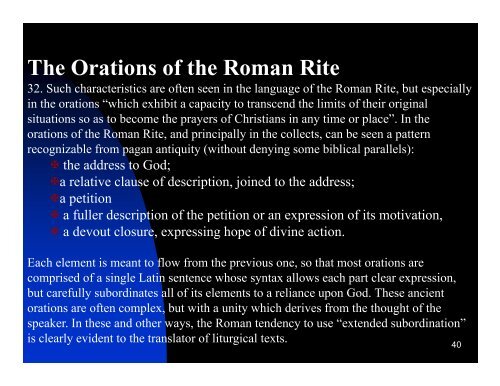The Translation of the Revised Roman Missal - Diocese of Paterson
The Translation of the Revised Roman Missal - Diocese of Paterson
The Translation of the Revised Roman Missal - Diocese of Paterson
You also want an ePaper? Increase the reach of your titles
YUMPU automatically turns print PDFs into web optimized ePapers that Google loves.
<strong>The</strong> Orations <strong>of</strong> <strong>the</strong> <strong>Roman</strong> Rite<br />
32. Such characteristics are <strong>of</strong>ten seen in <strong>the</strong> language <strong>of</strong> <strong>the</strong> <strong>Roman</strong> Rite, but especially<br />
in <strong>the</strong> orations “which exhibit a capacity to transcend <strong>the</strong> limits <strong>of</strong> <strong>the</strong>ir original<br />
situations so as to become <strong>the</strong> prayers <strong>of</strong> Christians in any time or place place” . In <strong>the</strong><br />
orations <strong>of</strong> <strong>the</strong> <strong>Roman</strong> Rite, and principally in <strong>the</strong> collects, can be seen a pattern<br />
recognizable from pagan antiquity (without denying some biblical parallels):<br />
<strong>the</strong> address to God;<br />
a relative clause <strong>of</strong> description, joined to <strong>the</strong> address;<br />
a petition<br />
a fuller description <strong>of</strong> <strong>the</strong> petition or an expression <strong>of</strong> its motivation, motivation<br />
a devout closure, expressing hope <strong>of</strong> divine action.<br />
Each element is meant to flow from <strong>the</strong> previous one, so that most orations are<br />
comprised <strong>of</strong> a single Latin sentence whose syntax allows each part clear expression,<br />
but carefully subordinates all <strong>of</strong> its elements to a reliance upon God. <strong>The</strong>se ancient<br />
orations are <strong>of</strong>ten complex, p but with a unity ywhich derives from <strong>the</strong> thought g <strong>of</strong> <strong>the</strong><br />
speaker. In <strong>the</strong>se and o<strong>the</strong>r ways, <strong>the</strong> <strong>Roman</strong> tendency to use “extended subordination”<br />
is clearly evident to <strong>the</strong> translator <strong>of</strong> liturgical texts.<br />
40



